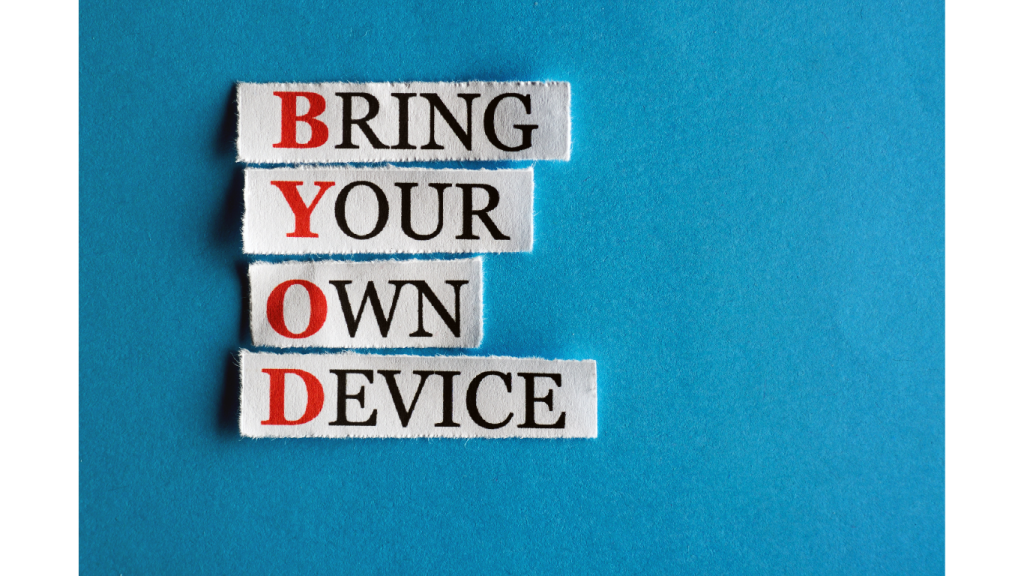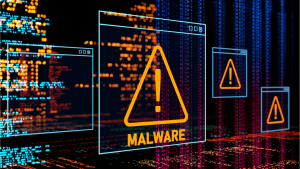Since the pandemic, the concept of Bring Your Own Device (BYOD) has gained significant traction. Allowing employees to use their personal devices for work can offer numerous benefits, such as increased flexibility, cost savings, and enhanced productivity.
However, BYOD also introduces a range of cybersecurity risks that small businesses must address to protect sensitive data and maintain the integrity of their networks.

Understanding the Benefits of BYOD
Before diving into the risks, it’s important to acknowledge why so many businesses are adopting BYOD:
Cost Savings
Small businesses often operate on tight budgets. BYOD allows companies to reduce the costs associated with purchasing, maintaining, and updating company-owned devices. Employees bear the cost of their own devices, reducing the financial burden on the business.
Increased Flexibility and Productivity
Employees are often more comfortable and productive when using devices they are familiar with. BYOD allows employees to work from anywhere, whether they’re in the office, at home, or on the go, which can lead to improved job satisfaction and work-life balance.
Streamlined Operations
With BYOD, employees can seamlessly transition between work and personal tasks without the need to carry multiple devices. This convenience can result in faster response times and greater efficiency, particularly for remote workers or those who frequently travel.
Despite these advantages, BYOD isn’t without its challenges. The flexibility and convenience it offers can open the door to serious cybersecurity risks if not properly managed.
The Risk of BYOD
While BYOD can boost productivity, it also presents several significant risks that small businesses need to be aware of:
Data Breaches and Loss
Personal devices are more prone to being lost or stolen than company-owned hardware. If a device containing sensitive business data is lost or stolen, the risk of a data breach is high, potentially exposing confidential information to unauthorized individuals.
Lack of IT Control and Visibility
IT departments have limited control over personal devices, which can lead to inconsistent security practices. This lack of control makes it difficult to enforce security policies, manage software updates, and monitor for potential threats, increasing the risk of vulnerabilities.
Inconsistent Security Measures
Employees may not prioritize security on their personal devices as much as they would on company-issued devices. Weak passwords, lack of encryption, and outdated software are common issues that can leave devices vulnerable to cyberattacks.
Increased Risk of Malware
Personal devices are often used for both work and personal activities. Downloading apps, visiting unsecured websites, or connecting to public Wi-Fi networks can introduce malware that could compromise both the device and the company network.
Shadow IT
When employees use unauthorized applications or services to perform work tasks, it creates “shadow IT.” This occurs outside the purview of the IT department, making it difficult to ensure that all tools and applications meet security standards. Shadow IT can lead to data leaks, compliance issues, and increased vulnerability to attacks.
Regulatory Compliance Challenges
Depending on your industry, regulatory requirements such as GDPR, HIPAA, or PCI-DSS may dictate how sensitive information is handled and protected. BYOD can complicate compliance efforts, as personal devices may not meet the necessary security standards, leading to potential violations and fines.
Best Practices for Managing BYOD Risks

To mitigate the risks associated with BYOD while still enjoying its benefits, small businesses should implement the following best practices:
Develop a Comprehensive BYOD Policy
A well-defined BYOD policy is the foundation of a secure BYOD environment. This policy should clearly outline the responsibilities of both the company and the employee, including:
- Acceptable Use: Define which work-related tasks can be performed on personal devices and which types of devices are allowed.
- Security Requirements: Specify security measures that must be in place, such as device encryption, use of strong passwords, and regular updates.
- Monitoring and Compliance: Explain how devices will be monitored for compliance with company policies and what actions will be taken in case of non-compliance.
- Support and Liability: Clarify what support the company will provide for personal devices and who is liable in case of data loss or device failure.
Implement Mobile Device Management (MDM)
Mobile Device Management (MDM) software is essential for securing and managing personal devices that access company data. MDM allows IT teams to:
- Enforce Security Policies: Remotely apply security settings such as password requirements, encryption, and VPN usage.
- Monitor Device Compliance: Track devices for compliance with the BYOD policy and identify potential security issues.
- Remote Wipe Capability: In case of device loss or theft, MDM enables IT to remotely wipe all company data from the device to prevent unauthorized access.
Ensure Strong Authentication and Access Control
Security begins with controlling access to company systems and data. To strengthen authentication:
- Require Strong, Unique Passwords: Employees should use complex passwords and change them regularly.
- Implement Multi-Factor Authentication (MFA): MFA adds an additional layer of security by requiring a second form of verification, such as a fingerprint or a one-time code, in addition to a password.
- Limit Access: Use role-based access controls to ensure that employees can only access the data and applications necessary for their job functions.
Regularly Update and Patch Devices
Keeping software up to date is one of the simplest yet most effective ways to protect against cyber threats:
- Automatic Updates: Encourage or require employees to enable automatic updates on their devices to ensure that they are always running the latest, most secure versions of operating systems and applications.
- Patch Management: Use MDM tools to enforce timely installation of security patches and updates across all BYOD devices.
Encrypt Sensitive Data
Encryption is a critical component of data security, especially for BYOD:
- Device Encryption: Require that all sensitive data stored on personal devices be encrypted. This ensures that, even if a device is lost or stolen, the data remains secure and unreadable to unauthorized users.
- Secure Communications: Implement encryption for all communications, including emails and messaging apps, to protect data in transit.
Educate Employees on Cybersecurity Best Practices
Continuous education is key to maintaining a secure BYOD environment:
- Training Programs: Regularly train employees on cybersecurity best practices, emphasizing the unique risks associated with BYOD. Topics should include recognizing phishing attacks, safe browsing habits, and the importance of securing personal devices.
- Awareness Campaigns: Run ongoing awareness campaigns to keep cybersecurity top-of-mind. Use real-world examples and scenarios to make the risks relatable and the training more effective.
Monitor and Audit Device Access
Regular monitoring and auditing are essential for maintaining control over BYOD:
- Access Logs: Keep detailed logs of device access to company systems. Regularly review these logs to identify any unusual or unauthorized activity.
- Audit Compliance: Conduct periodic audits to ensure that all devices comply with your BYOD policy and security requirements. Address any non-compliance issues promptly.
Prepare an Incident Response Plan
Even with the best precautions, incidents can happen. Be prepared:
- Incident Response Team: Establish a team responsible for responding to cybersecurity incidents involving BYOD. Ensure they are trained to handle situations like data breaches, malware infections, and lost or stolen devices.
- Response Procedures: Develop clear procedures for responding to BYOD-related incidents, including steps for containment, investigation, communication, and recovery.
- Post-Incident Review: After an incident, conduct a review to identify what went wrong and how similar incidents can be prevented in the future. Update your BYOD policy and security measures accordingly.
The Role of Cyber Insurance in BYOD Management
As businesses increasingly adopt Bring Your Own Device (BYOD) policies, the complexities of managing cybersecurity risks grow. While implementing strong security measures is essential, even the most well-prepared businesses can experience breaches or cyber incidents. This is where cyber insurance becomes a crucial component of a comprehensive BYOD strategy.
Why Cyber Insurance Matters in a BYOD Environment
In a BYOD environment, the diversity of devices and the varying levels of security across personal devices introduce unique challenges. Employees’ personal devices often have inconsistent security controls compared to corporate-owned devices, making them potential entry points for cybercriminals. If a breach occurs through a personal device, it can lead to significant financial losses, legal liabilities, and damage to the company’s reputation.
Cyber insurance serves as a financial safety net, covering various costs associated with cyber incidents. For businesses with BYOD policies, cyber insurance can provide coverage for several specific risks:
Data Breaches
If an employee’s personal device is lost, stolen, or compromised, leading to a data breach, cyber insurance can cover the costs of notifying affected individuals, conducting forensic investigations, and providing credit monitoring services. These expenses can be substantial, especially for small businesses that may not have the resources to handle them independently.
Regulatory Fines and Penalties
Depending on your industry, a data breach involving sensitive information, such as customer data or health records, can result in regulatory fines and penalties. Cyber insurance can help cover these fines and the legal costs associated with defending your business against regulatory actions.
Business Interruption
A cyber incident stemming from a BYOD device can disrupt business operations, leading to lost revenue. Cyber insurance often includes coverage for business interruption, compensating for income lost during the period your business is unable to operate normally due to a cyberattack.
Third-Party Liability
If a cyber incident that originates from an employee’s personal device affects your customers, partners, or other third parties, your business may be held liable for the damages. Cyber insurance can cover the costs of legal defense and any settlements or judgments that may arise from third-party claims.
Ransomware and Extortion
Ransomware attacks are a growing threat, and personal devices connected to your business network can be vulnerable targets. If an employee’s device becomes infected with ransomware and spreads to your network, cyber insurance can cover the costs of ransom payments, as well as the expenses involved in restoring your systems and data.
Customizing Cyber Insurance for BYOD
Not all cyber insurance policies are created equal, and it’s important to choose a policy that specifically addresses the risks associated with BYOD. When working with an insurance provider, discuss the following aspects to ensure your policy is tailored to your BYOD environment:
Device Coverage:
- Confirm that your policy covers incidents originating from personal devices. Some policies may exclude coverage for devices that are not company-owned, so it’s essential to clarify this upfront.
Policy Limits and Sub-Limits:
- Understand the limits of your policy, including any sub-limits for specific types of incidents, such as data breaches or business interruption. Ensure the coverage is sufficient to protect your business in the event of a significant cyber incident involving BYOD.
Incident Response Support:
- Many cyber insurance policies offer access to a network of experts, including cybersecurity consultants, legal advisors, and public relations professionals, to help manage and mitigate the impact of a cyber incident. Verify that your policy provides this support, particularly in scenarios involving personal devices.
Compliance Requirements:
- Cyber insurance policies often require businesses to follow certain cybersecurity best practices, such as maintaining up-to-date software, implementing strong access controls, and conducting regular employee training. Ensure that your BYOD policies and procedures align with these requirements to avoid any coverage disputes in the event of a claim.
Coverage for Emerging Threats:
- Cyber threats are constantly evolving, and new risks, such as those related to remote work or the Internet of Things (IoT), continue to emerge. Make sure your cyber insurance policy is adaptable and covers these emerging risks, which may be exacerbated by BYOD practices.
Integrating Cyber Insurance with Your BYOD Strategy
To maximize the effectiveness of cyber insurance in your BYOD strategy, consider the following steps:
Conduct a Risk Assessment:
- Work with your insurance provider to conduct a thorough risk assessment of your BYOD environment. Identify the most significant threats and vulnerabilities associated with personal devices, and use this information to guide your insurance coverage decisions.
Regularly Review and Update Your Policy:
- As your business grows and your BYOD practices evolve, it’s important to regularly review and update your cyber insurance policy. This ensures that your coverage remains adequate and relevant to your current risk landscape.
Educate Employees:
- Ensure that your employees understand the importance of cybersecurity in a BYOD environment and how cyber insurance fits into the broader security strategy. Employees should be aware of their role in maintaining security and the potential consequences of a breach.
Final Thoughts
Cyber insurance plays a crucial role in managing the risks associated with BYOD. While strong security measures are the first line of defense, cyber insurance provides essential financial protection and support in the event of a cyber incident. By choosing a policy tailored to your BYOD environment and integrating it into your overall cybersecurity strategy, you can safeguard your business against the unique challenges posed by personal devices.
As BYOD continues to grow in popularity, the importance of having a comprehensive, well-integrated cyber insurance policy cannot be overstated. If you need guidance on selecting the right coverage or want to assess your current BYOD risks, consider consulting with a cybersecurity professional to ensure your business is fully protected.

